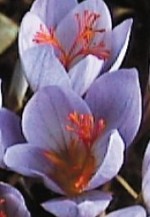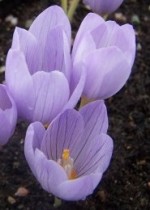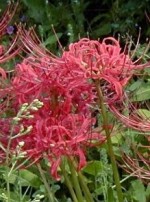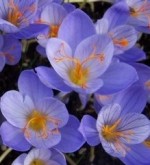
The choice of fall blooming bulbs is more restrictive than that of spring blooming bulbs. Here are some favorites. (Sorry, there are no common names for these)
CROCUS
Yes, they are cousins of the spring blooming crocuses They have the same sort of flower, are just as easy to grow, but are different species. Plant the bulbs (actually corms) in a gritty, well-drained soil and hope that voles and chipmunks don’t find them.
-
Height: 5-6”
Bloom Date: September into October
Colors: white, various shades of blue
Hardiness: Zones 4-9
Recommended Cultivars: ‘Conqueror’ (sky blue), ‘Oxonian’ (violet blue), ‘Albus’ (white), Cassiope (aster blue with yellow; has largest flower of C. speciosus)
 Crocus kotschyanus/zonatus
Crocus kotschyanus/zonatus
Flowers smaller than those of C. speciosus.
-
Height: 3-5
Bloom Date: September or October
Color: Pale to mid bluish lilac with conspicuous darker veins, yellow blotches at the base of each petal, and whitish throat.
Hardiness: Zones 3-5
 Crocus sativus
Crocus sativus
Although often offered for sale, don’t bother with this one; it is the saffron crocus but you will never get enough saffron to make a single meal. Besides, it is difficult to grow well.
Colchicum
Although Colchicums look a lot like crocuses they are not closely related. There flowers are larger and their bulbs (corms) are pointed on top like a tulip bulb. The best news is, however, that the wildlife don’t like them. The coarse leaves of colchicum pop up in spring, turn yellow, and die by early summer. The flowers appear without foliage in fall. Plant in rich, well drained soil in partial shade, in a place where the dying foliage will not be a problem.
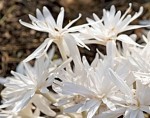
 Colchicum autumnale
Colchicum autumnale
Each corm sends up 1-6 flowers. Both single and double forms are available.
-
Height: 4-7”
Bloom Time: mid to late fall
Color: purplish-pink; white
Hardiness: Zones 5-8
Recommended Cultivars: ‘Albus’ (single white, smaller and very floriferous than others), ‘Alboplenum’ (double white, flowers 4-6” across)
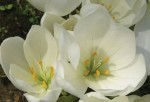
 Colchicum speciosus
Colchicum speciosus
Flowers larger than those of C. autumnale
-
Height: 6-12”
Bloom Time: September -October
Color: Various shades of purple with white throat; white
Hardiness: 5-8
Recommended Cultivars: ‘Album’ (white; clump-forming ), ‘Atrorubens’ (reddish-purple)
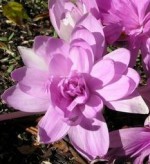
 Hybrid Colchicum ‘Waterlily’
Hybrid Colchicum ‘Waterlily’
Flowers are 4-5” across and double.
-
Height: 5-6”
Bloom Time: late fall
Color: pinkish-purple
Hardiness: Zones 5-8
LYCORIS
Also known as ‘rain lilies’ because the flower stalks pop up after heavy rain.
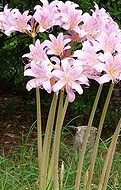
 Lycoris squamigera
Lycoris squamigera
Plant in light shade to full sun in moist, humsey soil.
-
Height: 1 ½-2’
Bloom Time: Early fall followed by leaves in spring
Color: Pink
Hardiness: 5-9
-
Height: 1-2’
Bloom Time: September followed by leaves in October
Color: Red
Hardiness: Zones 5b-10
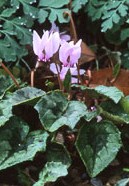 IVY LEAVED CYCLAMEN (Cyclamen hederifolium)
IVY LEAVED CYCLAMEN (Cyclamen hederifolium)
Plant in shady, well-drained, humusy soil. Rot can be a problem so if possible plant on a slope to facilitate good drainage.
-
Height: 3-6”
Bloom Time: August-October
Color: White, pink
Hardiness: Zones 6-8
These selections offer a splash of color to the fall garden and will catch the eye of most gardeners. Many of them may not be familiar and the reason may be the price. Sticker shock is a problem. The bulbs run about $3-10+ a piece with $5-6 being most common. You don’t need a lot of them to make an impact especially since not much else is blooming and that fact makes them more affordable.
